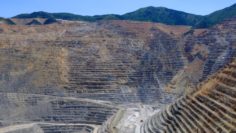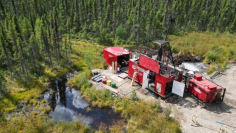ACN 119 057 457, AUSTRALIAN SECURITIES EXCHANGE ANNOUNCEMENT, 31 August 2021
HIGHLIGHTS
– Das Prospektionsgebiet Cascata ist eine neue Entdeckung, bei der es sich wahrscheinlich um vulkanogenes Massivsulfid (VMS) handelt. Auf einer Streichenlänge von über 6 km wurden durchgängig Sulfide an der Oberfläche entdeckt. Das interessierende Gebiet ist etwa 15 km2 groß und liegt vollständig innerhalb der bestehenden Ryberg-Lizenz des Unternehmens. Mit den Bohrungen wurde begonnen.
– SODD003 (Sortekap-Prospekt) ist abgeschlossen und durchteufte auf 78 m aussichtsreiche Quarzadern mit Sulfidmineralisierung innerhalb von Amphibolit. Das Ziel ist Gold, wobei frühere Oberflächenproben in der Nähe einen Gehalt von bis zu 2,7 g/t Gold aufweisen.
– SODD002 (Sortekap-Prospekt) ist abgeschlossen und durchteufte ~6% vereinzeltes Chalkopyrit + Pyrrhotit über 7,1m aus 188,5m Bohrlochtiefe. Es wurden auch Zonen mit vereinzeltem Pyrit angetroffen.
– 1 x Bohrgerät wurde zu einem elektromagnetischen Ziel auf dem Miki-Prospekt mobilisiert
Conico Limited (ASX: CNJ) (“Conico” oder “das Unternehmen”) und seine hundertprozentige Tochtergesellschaft Longland Resources Ltd (“Longland”) freuen sich bekannt zu geben, dass eine neue Entdeckung, die als wahrscheinliches vulkanogenes Massivsulfid (VMS) interpretiert wird, entdeckt wurde und eine Bohrung begonnen hat. Die Bohrungen SODD002 und SODD003 wurden bei Sortekap und die Bohrung MIDD008 auf dem Miki-Prospekt abgeschlossen.
Thomas Abraham-James, CEO von Longland, sagte:
“Die Entdeckung eines potenziellen neuen VMS-Vorkommens bei Cascata ist ein typisches Beispiel dafür wie chancenreich die Exploration in Grönland ist. Unser Team hat mehr als 6 km des Streichens zu Fuß abgewandert, wobei Lithologien mit Aussicht auf VMS und eine konsistente Sulfidmineralisierung beobachtet wurden, was eine sofortige Bohrung rechtfertigt. In der Zwischenzeit sehen wir weiterhin Mineralisierungen in den Bohrlöchern bei Miki und Sortekap.”
Das neu entdeckte Prospektionsgebiet Cascata
Im Rahmen der Erkundungsexploration wurden auffällige Kupfer- und Eisensulfide identifiziert, die als Cascata-Prospekt bezeichnet werden (Abbildung 1). Die Mineralisierung liegt in Form von Pyrit, Chalkopyrit und Bornit in massiven, halbmassiven, stockförmigen und vereinzelten Formen vor und steht in Zusammenhang mit Schwarzschiefer, rhyolitischem Vulkanismus und darunter liegendem Amphibolit (Abbildungen 2-7). Die bisher durchgeführten Felduntersuchungen deuten darauf hin, dass es sich bei Cascata möglicherweise um ein vulkanogenes Massivsulfidvorkommen (VMS) handelt, wobei eine Streichenlänge von mehr als 6 km zu Fuß abgeschritten wurde und ein Gebiet von Interesse von ~15 km2 identifiziert wurde.
Die Bohrungen bei Cascata haben begonnen und befinden sich am oberen Ende der Stratigraphie. Das Projekt befindet sich innerhalb der bestehenden Ryberg-Lizenz und ist leicht zugänglich, nur 6 km von der Küste entfernt und verfügt über reichlich Süßwasserquellen.
Prospektionsgebiet Sortekap: Bohrloch SODD003
Das Bohrloch SODD003 zielte auf eine Goldmineralisierung in Amphibolit (Abbildung 9) ab und wurde so positioniert, dass es senkrecht zu Quarzadern gebohrt wurde, in denen frühere Oberflächenproben Gehalte von bis zu 2,7 g/t Gold ergaben.
Das Bohrloch durchteufte erfolgreich 78 m aussichtsreichen quarzhaltigen Amphibolit, beginnend an der Oberfläche (Abbildung 8). Die Quarzadern enthielten häufig Spurensulfide bzw. disseminierte Sulfide, was insofern ermutigend ist, als die veröffentlichte Literatur über die Goldvorkommen bei Sortekap besagt, dass die Goldmineralisierung mit dem Vorhandensein von Spurensulfiden (insbesondere Arsenopyrit) im Amphibolit in Zusammenhang steht. Die angetroffenen Sulfide umfassen Arsenopyrit in Verbindung mit Pyrit und Chalkopyrit (Abbildungen 10-11).
Das Bohrloch wurde im Serpentinit beendet und das Bohrgerät wurde inzwischen zum nächsten Bohrloch auf dem Miki-Prospekt verlegt, um eine elektromagnetische (EM) Anomalie zu erbohren, die bei der EM-Untersuchung 2020 identifiziert wurde.
Prospektionsgebiet Sortekap: Bohrung SODD002
Das Bohrloch SODD002 befand sich im Sortekap-Prospekt und zielte auf eine aufladbare Anomalie durch induzierte Polarisation (IP) ab. Das Bohrloch durchteufte erfolgreich eine Sulfidmineralisierung über mehrere Abschnitte, wobei der bedeutendste Abschnitt 7,1 m lang ist, der bei 188,5 m Bohrlochtiefe beginnt und aus ~6 % verstreutem Chalkopyrit und Pyrrhotit besteht. Tiefer im Bohrloch gibt es Zonen mit bis zu 20 % verstreutem Pyrit (Abbildung 12).
Die Bohrung wurde auf eine Gesamttiefe von 356 m verlängert, um den in Bohrung SODD001 entdeckten Serpentinit zu durchteufen. Dadurch wird die Geologie der beiden Sortekap-Bohrungen miteinander verknüpft, was zu einem besseren Verständnis der regionalen Stratigraphie führt.
Miki Prospektionsgebiet: Bohrung MIDD008
Dieses Bohrloch zielte auf magmatische Sulfide ab, die mit dem Miki Fjord Macrodyke verbunden sind (Abbildung 16). Von 78,9 m bis zum Ende des Bohrlochs (312 m) durchteufte MIDD008 eine Quarz-Kalifeldspat-Glimmer-Assemblage (Abbildungen 13 bis 14), die Adern mit Molybdänit (zwischen 1 und 2 %, wenn sie angetroffen wurde) und Spuren von Chalkopyrit (~ 2 %, wenn sie angetroffen wurde, Abbildung 15) enthält.
Die Entdeckung einer solchen Mineralisierung ist unerwartet, aber nicht überraschend, wenn man die Nähe zu bekannten Systemen wie dem 38 km westlich gelegenen Porphyr-Molybdän-Projekt Flammefjeld bedenkt.
Das Bohrloch wurde in 312 m Bohrtiefe beendet, als es sich noch im alterierten Gestein befand, und das Bohrgerät wurde zum Prospektionsgebiet Cascata umdisponiert.
Im Auftrag des Vorstandes.
/
Guy T Le Page, FFIN, MAusIMM
Executive Director
COMPETENT PERSONS STATEMENT
The information contained in this report relating to exploration results relates to information compiled or reviewed by Thomas Abraham-James, a full-time employee of Longland Resources Ltd. Mr. Abraham-James has a B.Sc. Hons (Geol) and is a Chartered Professional (CPGeo) and Fellow of the Australasian Institute of Mining and Metallurgy (FAusIMM). Mr. Abraham-James has sufficient experience of relevance to the styles of mineralisation and the types of deposit under consideration, and to the activities undertaken to qualify as a Competent Person as defined in the 2012 edition of the Joint Ore Reserve Committee (JORC) “Australasian Code for Reporting of Exploration Results, Mineral Resources and Ore Reserves”. Mr. Abraham-James consents to the inclusion in this report of the matters based on information in the form and context in which it appears.
FORWARD-LOOKING STATEMENTS
This announcement contains forward-looking statements that involve a number of risks and uncertainties. These forward-looking statements are expressed in good faith and believed to have a reasonable basis. These statements reflect current expectations, intentions or strategies regarding the future and assumptions based on currently available information. Should one or more of the risks or uncertainties materialise, or should underlying assumptions prove incorrect, actual results may vary from the expectations, intentions and strategies described in this announcement. No obligation is assumed to update forward-looking statements if these beliefs, opinions and estimates should change or to reflect other future developments.
Annex 1
| Hole ID | Easting | Northing | Elevation | Dip | Azimuth | Length |
| MIDD001 | 565,714 | 7,571,884 | 298m | -80 | 215 | 217.0m |
| MIDD002 | 565,840 | 7,571,990 | 312m | -80 | 355 | 313.5m |
| MIDD003 | 565,734 | 7,571,883 | 298m | -80 | 215 | 180.0m |
| MIDD004 | 565,715 | 7,571,897 | 299m | -80 | 290 | 36.0m |
| MIDD005 | 565,797 | 7,571,960 | 311m | -70 | 285 | 381.0m |
| MIDD006 | 565,728 | 7,571,889 | 298m | -75 | 290 | 153.0m |
| MIDD007 | 566,497 | 7,573,151 | 386m | -70 | 290 | 278.0m |
| MIDD008 | 566,880 | 7,573,889 | 567m | -80 | 290 | 312.0m |
| MIDD009 | 565,910 | 7,571,891 | 318m | -90 | 000 | N/A |
| SODD001 | 567,481 | 7,601,155 | 1,319m | -80 | 355 | 287.0m |
| SODD002 | 567,518 | 7,600,827 | 1,240m | -85 | 095 | 356.0m |
| SODD003 | 567,496 | 7,600,712 | 1,203m | -70 | 290 | 117.0m |
| CADD001 | 593,237 | 7,585,297 | 795m | -70 | 290 | N/A |
All coordinates are displayed in WGS84 UTM Zone 25N
Annex 2
JORC Code, 2012 Edition
Section 1: Sampling Techniques and Data
| Criteria | JORC Code Explanation | Commentary |
| Sampling techniques |
Nature and quality of sampling (e.g., cut channels, random chips, or specific specialised industry standard measurement tools appropriate to the minerals under investigation, such as down hole gamma sondes, or handheld XRF instruments, etc.). These examples should not be taken as limiting the broad meaning of sampling. | * Sampling of MIDD008, SODD002 & SODD003 was conducted using standard industry practices with diamond drilling. Magnetic readings were taken using a Reflex EZ-Trac downhole survey tool. |
| Include reference to measures taken to ensure sample representivity and the appropriate calibration of any measurement tools or systems used. | * Drill-holes MIDD008, SODD002 & SODD003 were angled to optimally intersect the interpreted contact with an IP conductor or adjacent to lithologies of interest. | |
| Aspects of the determination of mineralisation that are Material to the Public Report. In cases where ‘industry standard’ work has been done this would be relatively simple (e.g., ‘reverse circulation drilling was used to obtain 1 m samples from which 3 kg was pulverised to produce a 30 g charge for fire assay’). In other cases, more explanation may be required, such as where there is coarse gold that has inherent sampling problems. Unusual commodities or mineralisation types (e.g., submarine nodules) may warrant disclosure of detailed information. | * Mineralisation in drill-holes MIDD008, SODD002 & SODD003 has not been quantitively determined and is awaiting assay. The determination in this report is qualitative, based on visual observation made by the Competent Person who is a geologist on site. | |
| Drilling techniques | Drill type (e.g., core, reverse circulation, open-hole hammer, rotary air blast, auger, Bangka, sonic, etc) and details (e.g., core diameter, triple or standard tube, depth of diamond tails, face-sampling bit or other type, whether core is oriented and if so, by what method, etc.). | * Wireline diamond drilling using a 56.5mm diameter drill bit and standard tube. The core has not been orientated but has been surveyed using a Reflex EZ-Trac multi-shot tool. The drill rig is a CDI 500 heli-portable fly rig operated by Cartwright Drilling Inc. |
| Drill sample recovery | Method of recording and assessing core and chip sample recoveries and results assessed. | * All drill core has been geotechnically logged with core recovery measured per drill core run (3m). |
| Measures taken to maximise sample recovery and ensure representative nature of the samples. | * The drill crew was notified of the target depth and likelihood of intersecting sulphides, accordingly they eased pressure on the drill bit from that depth onward to minimise the chance of core destruction. All drill core was then placed in trays with lids to ensure that no core was lost during transportation from the drill site to core logging facility. The drill core was then reconstructed into continuous runs on an angle iron cradle by the geologist. Depths were checked against depths indicated on the core blocks. | |
| Whether a relationship exists between sample recovery and grade and whether sample bias may have occurred due to preferential loss/gain of fine/coarse material. | * Not applicable as no assays have been conducted to date. | |
| Logging | Whether core and chip samples have been geologically and geotechnically logged to a level of detail to support appropriate Mineral Resource estimation, mining studies and metallurgical studies. | * All drill core has been geologically and geotechnically logged by a qualified geologist to a level of detail that supports appropriate Mineral Resource estimation, mining studies and metallurgical studies. |
| Whether logging is qualitative or quantitative in nature. Core (or costean, channel, etc.) photography. | * The logging is qualitative. All drill core was photographed. | |
| The total length and percentage of the relevant intersections logged. | * Drill-holes MIDD008, SODD002 & SODD003 have been logged in full. | |
| Sub-sampling techniques and sample preparation | If core, whether cut or sawn and whether quarter, half or all core taken. | * No sampling has been undertaken. |
| If non-core, whether riffled, tube sampled, rotary split, etc and whether sampled wet or dry. | * Not applicable as the drill-hole is core. | |
| For all sample types, the nature, quality and appropriateness of the sample preparation technique. | * Not applicable as no sampling has been undertaken. | |
| Quality control procedures adopted for all sub-sampling stages to maximise representivity of samples. | * Not applicable as no sampling has been undertaken. | |
| Measures taken to ensure that the sampling is representative of the in-situ material collected, including for instance results for field duplicate/second-half sampling. | * Not applicable as no sampling has been undertaken. | |
| Whether sample sizes are appropriate to the grain size of the material being sampled. | * Not applicable as no sampling has been undertaken. | |
| Quality of assay data and laboratory tests | The nature, quality and appropriateness of the assaying and laboratory procedures used and whether the technique is considered partial or total. | * Not applicable as no assaying has occurred. |
| For geophysical tools, spectrometers, handheld XRF instruments, etc., the parameters used in determining the analysis including instrument make and model, reading times, calibrations factors applied and their derivation, etc. | * Downhole magnetic readings were taken using a Reflex EZ-Trac. Readings were taken every 3m at completion of drilling, with the survey beginning at bottom of hole and working up. The tool protruded beyond the drill string by 3m to ensure no interference from the rods. The magnetic roll is 0 to 360 with an accuracy of ±0.35 . The magnetic range is 0 to 100,000 nT with an accuracy of ±50 nT. | |
| Nature of quality control procedures adopted (e.g., standards, blanks, duplicates, external laboratory checks) and whether acceptable levels of accuracy (i.e., lack of bias) and precision have been established. | * Not applicable as no sampling or assaying has occurred. | |
| Verification of sampling and assaying | The verification of significant intersections by either independent or alternative company personnel. | * Consultants utilised by the Company have verified the findings of the on-site geologists. |
| The use of twinned holes. | * Not applicable as no twinned holes have been drilled. | |
| Documentation of primary data, data entry procedures, data verification, data storage (physical and electronic) protocols. | * All logging data was entered into a computer on site, with daily backups taken and stored on hard drives and the cloud. | |
| Discuss any adjustment to assay data. | * Not applicable as no assaying has occurred. | |
| Location of data points | Accuracy and quality of surveys used to locate drill holes (collar and down-hole surveys), trenches, mine workings and other locations used in Mineral Resource estimation. | * Drill-holes MIDD008, SODD002 & SODD003 were located using a handheld Garmin GPS with an accuracy of ±4m. |
| Specification of the grid system used. | * UTM WGS84 Zone 25N. | |
| Quality and adequacy of topographic control. | * Topographic information was sourced from the Greenland Mapping Project (GIMP) digital elevation model (30m accuracy). | |
| Data spacing and distribution | Data spacing for reporting of Exploration Results. | * Not applicable as the drill-holes are targeting specific geological and IP targets. |
| Whether the data spacing, and distribution is sufficient to establish the degree of geological and grade continuity appropriate for the Mineral Resource and Ore Reserve estimation procedure(s) and classifications applied. | * Not applicable as the drill-holes are targeting specific geological and IP targets. | |
| Whether sample compositing has been applied. | * Not applicable as no sampling has occurred. | |
| Orientation of data in relation to geological structure | Whether the orientation of sampling achieves unbiased sampling of possible structures and the extent to which this is known, considering the deposit type. | * The strike and dip of drill-holes MIDD008, SODD002 & SODD003 were designed to intersect an IP target/lithological unit at an adjacent angle, not along strike. Therefore, the sampling conducted by the drill-hole is considered unbiased. |
| If the relationship between the drilling orientation and the orientation of key mineralised structures is considered to have introduced a sampling bias, this should be assessed and reported if material. | * There are no known biases caused by the orientation of drill-holes MIDD008, SODD002 & SODD003. | |
| Sample security | The measures taken to ensure sample security. | * The drill core is stored onboard the Company’s charter vessel which is considered highly secure. |
| Audits or reviews | The results of any audits or reviews of sampling techniques and data. | * No audits or reviews have been carried out at this time. |
Section 2: Reporting of Exploration Results
| Criteria | JORC Code explanation | Commentary |
| Mineral tenement and land tenure status | Type, reference name/number, location and ownership including agreements or material issues with third parties such as joint ventures, partnerships, overriding royalties, native title interests, historical sites, wilderness or national park and environmental settings. | * The Ryberg Project is wholly within Mineral Exploration Licences 2017/06 and 2019/38, located on the east coast of Greenland. They are held 100% by Longland Resources Ltd, a wholly owned subsidiary of Conico Ltd. |
| The security of the tenure held at the time of reporting along with any known impediments to obtaining a licence to operate in the area. | * The tenure is secure and in good standing at the time of writing. There are no known impediments. | |
| Exploration done by other parties | Acknowledgment and appraisal of exploration by other parties. | * Previous work mentioned (2017 VTEM survey) was planned and managed by Longland Resources Ltd, a wholly owned subsidiary of Conico Ltd. * Historic rock-chip sampling was conducted by Platina Resources Ltd and University of Leicester. |
| Geology | Deposit type, geological setting and style of mineralisation. | * Deposit types: Magmatic & VMS. * Geological setting: The project area is located within the North Atlantic Igneous Province (NAIP), a Tertiary volcanic centre that covered an area of approximately 1.3 million km2 in continental flood basalts (6.6 million km3 in volume), making it one of the largest volcanic events in history. Volcanism is associated with the opening of the North Atlantic, and presence of a mantle plume (what is now the Icelandic hotspot). The project area represents an erosional interface where the flood basalts have been removed, revealing the basement geology beneath. The project area is adjacent to a triple junction (failed rift) and consists of Archaean orthogneiss, Tertiary gabbro/flood basalt, and Cretaceous-Tertiary sediments (rift valley basin). Approximately 70% of the geology within the sedimentary basin has been intruded by Tertiary sills that are feeders to the overlying plateau basalts. There are also feeder dykes and layered mafic intrusions – it is likely that there is also a large ultramafic body present at depth, evidence for this is in the form of ultramafic xenoliths brought to surface by magma conduits. * Style of mineralisation: magmatic copper and nickel sulphides with appreciable cobalt, palladium and gold. |
| Drill hole Information | A summary of all information material to the understanding of the exploration results including a tabulation of the following information for all Material drill holes: – easting and northing of the drill hole collar – elevation or RL (Reduced Level – elevation above sea level in metres) of the drill hole collar – dip and azimuth of the hole – down hole length and interception depth – hole length. |
* Refer to Annex 1. |
| If the exclusion of this information is justified on the basis that the information is not Material and this exclusion does not detract from the understanding of the report, the Competent Person should clearly explain why this is the case. | * This is not the case.
|
|
| Data aggregation methods | In reporting Exploration Results, weighting averaging techniques, maximum and/or minimum grade truncations (e.g., cutting of high grades) and cut-off grades are usually Material and should be stated. Where aggregate intercepts incorporate short lengths of high-grade results and longer lengths of low-grade results, the procedure used for such aggregation should be stated and some typical examples of such aggregations should be shown in detail. |
* Not applicable as no sampling or assaying has occurred. |
| The assumptions used for any reporting of metal equivalent values should be clearly stated. | * Not applicable as no sampling or assaying has occurred. | |
| Relationship between mineralisation widths and intercept lengths | – These relationships are particularly important in the reporting of Exploration Results. – If the geometry of the mineralisation with respect to the drill hole angle is known, its nature should be reported. – If it is not known and only the down hole lengths are reported, there should be a clear statement to this effect (e.g., ‘down hole length, true width not known’). |
* The geometry of the mineralisation with respect to the drill-hole angle is not known. All reported lengths are in reference to down-hole length, true width not known. |
| Diagrams | Appropriate maps and sections (with scales) and tabulations of intercepts should be included for any significant discovery being reported These should include, but not be limited to a plan view of drill hole collar locations and appropriate sectional views. | * Refer to Figures 1,4, 5, 6, 7 and 10. |
| Balanced reporting | Where comprehensive reporting of all Exploration Results is not practicable, representative reporting of both low and high grades and/or widths should be practiced to avoid misleading reporting of Exploration Results. | * Not applicable as no sampling or assaying has occurred. |
| Other substantive exploration data | Other exploration data, if meaningful and material, should be reported including (but not limited to): geological observations; geophysical survey results; geochemical survey results; bulk samples – size and method of treatment; metallurgical test results; bulk density, groundwater, geotechnical and rock characteristics; potential deleterious or contaminating substances. | * Previous exploration results are detailed in: Conico Ltd press release on the 11th of December 2020, entitled ‘EM Survey Reveals Highly Prospective Chonolith at Ryberg‘. Conico Ltd press release on the 29th of July 2020, entitled ‘Conico to acquire East Greenland projects via acquisition of Longland Resources‘. Holwell et al, Mineralium Deposita, 2012, 47:3-21. |
| Further work | The nature and scale of planned further work (e.g., tests for lateral extensions or depth extensions or large-scale step-out drilling). | * Diamond drilling testing for lateral extensions of mineralisation, and large-scale step-out drilling. |
| Diagrams clearly highlighting the areas of possible extensions, including the main geological interpretations and future drilling areas, provided this information is not commercially sensitive. | * Refer to Figures 1, 5 & 10. |













